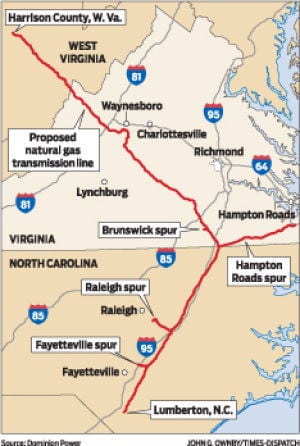
Posted on 01/25/2016 10:15:38 AM PST by thackney
The U.S. Forest Service has rejected the latest proposed route of the Atlantic Coast Pipeline because of the 42-inch natural gas pipeline's potential damage to the habitat of sensitive animal species protected by two national forests in Virginia and West Virginia.
In a letter to the Dominion-led pipeline company on Tuesday, the Forest Service said the proposed route is "inconsistent" with Forest Service plans and commitments to protect the habitats of the Cow Knob salamander, Cheat Mountain salamander and West Virginia northern flying squirrel, as well as the red spruce forest ecosystem in which they live.
Consequently, the pipeline project does not meet the agency's minimum requirements for a special use permit to cross the George Washington and Monongahela national forests, said Kathleen Atkinson, regional forester for the Eastern Region, and Tony Tocke, regional forester for the Southern Region. "Therefore, alternatives must be developed to facilitate further processing of the application."
"Alternatives must avoid the Cheat Mountain and Cow Knob salamanders and their habitats, the West Virginia northern flying squirrel, and spruce ecosystem restoration areas," they said in the letter, filed Thursday at the Federal Energy Regulatory Commission, which is reviewing the application for the proposed 550-mile natural gas pipeline.
The decision is the second time the Forest Service has blocked a proposed route for the pipeline because of its likely effect on endangered species, but Dominion, the Richmond-based energy company that leads the pipeline partnership, said it remains optimistic that it would find a route that would satisfy the Forest Service's concerns.
"Today's letter is part of the permitting process as we work cooperatively to find the best route with the least impact," Dominion spokesman Jim Norvelle said Thursday. "We appreciate the (Forest Service's) examination of this option and remain confident we will find an acceptable route."
However, the Forest Service also raised concerns about the pipeline company's plan to drill under the Blue Ridge Parkway and Appalachian Trail in the Blue Ridge Mountains between Augusta and Nelson counties. The proposed use of "horizontal directional drilling" would tunnel through the mountain and emerge next to the entrance to Wintergreen Resort in Nelson.
The regional foresters informed the company that the Forest Service would review the technical feasibility of the drilling proposal and any contingency plans in case the technology doesn't work. They also cautioned that the agency could require the company to complete the proposed drilling successfully before allowing construction of the pipeline to proceed through the national forests.
"I think the Forest Service is skeptical about the drilling," said Greg Buppert, senior attorney at the Southern Environmental Law Center in Charlottesville.
The law center is among 44 organizations in Virginia and West Virginia that formed the Allegheny-Blue Ridge Alliance to oppose the Atlantic Coast Pipeline, as well as the Mountain Valley Pipeline proposed to extend from West Virginia through the Roanoke Valley to Pittsylvania County and other potential natural gas pipeline projects through western Virginia.
The alliance and other opponents cheered the Forest Service's decision to block the route that the Atlantic Coast Pipeline proposed in late October as a way to satisfy Forest Service concerns about harm to Cow Knob salamander habitat on Shenandoah Mountain, between Highland and Augusta counties in the George Washington National Forest, and the Cheat Mountain salamander in the Monongahela National Forest in West Virginia.
"Dominion has persistently tried to force its pipeline through two national forests while ignoring calls to fully analyze less destructive options," the alliance said in a statement on Thursday. "The rejection of the preferred route by the Forest Service underscores how shallow Dominion's analysis has been."
The Forest Service's concerns about the proposed alternative prompted FERC staff to direct the pipeline company in early December to evaluate a different route that would avoid the sensitive wilderness areas and ensure that it complies with Forest Service management plans. The staff said then it could not issue a schedule for completing an environmental assessment of the project until the evaluation is done.
Ben Luckett, staff attorney at Appalachian Mountain Advocates, said the proposed 125-foot-wide construction right of way and 75-foot-wide permanent right of way for the pipeline would result in clear-cutting through the national forests, "causing dramatic forest fragmentation through some of the most high-quality forest habitat in our region."
Buppert, at the Southern Environmental Law Center, called on Dominion to "step back and truly reconsider the need for this pipeline at all."
"The decision I think represents a significant delay in Dominion's plans," he said.
Dominion and its partners in the pipeline company say the $5 billion project is essential to transporting low-priced natural gas from the Marcellus shale field in northern West Virginia to power plants and under-served markets on the Atlantic Coast of Virginia and North Carolina. They say it would lower electricity costs for consumers, provide a cheap and reliable source of fuel for manufacturers and gas distributors, and help utilities retire dirtier coal-fired power units.
The project was announced by Virginia Gov. Terry McAuliffe and Dominion CEO Thomas F. Farrell III more than a year ago. After a year of preliminary work, the company filed a formal application last fall.
Opposition has been fiercest in Nelson and Augusta among the 10 jurisdictions in Virginia that the pipeline would cross, but concerns also have been raised in Highland and Buckingham counties.
Rick Webb, coordinator of the Dominion Pipeline Monitoring Coalition and a longtime environmental scientist at the University of Virginia, said he was "pleased and gratified" by the Forest Service's action.
"They've pretty much drawn a firm line that (the pipeline is) not going to cross Shenandoah Mountain and Cheat Mountain, which is very good news," said Webb, who lives in Highland.

Seriously, why don’t we all just shelter in place because, you know, some critter somewhere could get injured. And, aren’t we all adding to the carbon footprint anyway by working, or living? So let’s just shut it all down — all of it.

I am so sick of tired of being tired of this crap. Environmentalists need to go to hell...an be done with it
Freegards
LEX
No surprise there.
Must protect the salamanders and squirrels .. From any and all “assumed” and “projected” possible potential dangers.
Environmentalists are just useful idiots. Turn the land over to the states.
And this is why the Feds shouldn’t own these lands.
Why not use existing electrical transmission rights of way? There are already enough of those cutting through the forests and over mountains in WV and western VA.
Need to shut off the gas to region they can heat their homes with wind and solar.
Why not using existing rights of way, following electric transmission lines or along highways?
We prefer to co-locate with existing rights of way where possible, but oftentimes it is not feasible. For example, electric transmission lines can traverse steep terrain in ways pipelines cannot. In addition, there often is not enough room along highway rights of way or there are other restrictions.

Cow Knob Salamander

Cheat Mountain Salamander

Cheat Mountain train wreck. They had one trainwreck and don't want a pipeline wreck
You would think that WV would readily endorse the pipeline as a means of exporting their natural gas. Especially given the decline of coal. Good for their economy but I am sure the NIMBY's (not in my back yard) will fight tooth and nail to support the Forest Service's position.
I’d be willing to bet that many of these Forest Service employees enjoy heat from natural gas, in their homes and offices...and that travels through a pipeline.
Oh, what irony.
Of course they do.
If we are blessed with a shillary or burnie loss these USFS people should be let go and the rest sent packing back to tending Smokey the Bear.
Ben Luckett, staff attorney at Appalachian Mountain Advocates, said the proposed 125-foot-wide construction right of way and 75-foot-wide permanent right of way for the pipeline would result in clear-cutting through the national forests, “causing dramatic forest fragmentation through some of the most high-quality forest habitat in our region.”
Bullspit. It creates habitat.
Game Trails
Electric power rights-of-way, depending on the voltage of the overhead lines, the cross-connections, and the height of the power lines (lowest point) can generate difficult underground voltages (corrosion and static voltages both) in pipelines that are parallel to the power lines.
Even if you “absolutely have to cross” the pipeline easement with the high voltage easement, you get construction problems, the galvanic corrosion and induced static charges, a nd the “parallel path” hills problem during construction.
Best to keep them separate. Or cross perpendicular to the other line.
Pipelines are built in HV Right-of-Ways.
Voltage mitigation is an expense, but not a major expense.
I call them fields of fire and ambush lanes but whatever.
Disclaimer: Opinions posted on Free Republic are those of the individual posters and do not necessarily represent the opinion of Free Republic or its management. All materials posted herein are protected by copyright law and the exemption for fair use of copyrighted works.